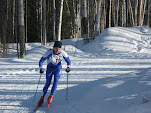Bye Olympics
For the US, the 20th Winter Olympics seemed to be up and down, and in the end somewhat forgetable. There were a few heroes, like Ted Ligety, Julia Mancusco, the Flying Tomato, and Joey Cheek, but some goats as well. These were the Hate Bode Games, and that's too bad. Watch for Bode to drop in the World Cup standings from third to about fifth. He might make up a place or two by the end of March. The future is anybody's guess, but I have an inkling he'll come back ready to dominate over the next year or two--if, and that's a big if, he can stay healthy. With alpine skiing, it's not a matter of if you're going to face some major injuries. Julia Macusco went from tiara'd downhill goat to hero in just two minutes of intense giant slalom racing. Good on her. Ex-Olympian Picabo Street came across as a bit of a goat for criticizing the team, especially Mancusco, on the day that Mancusco won the Gold.
The biggest goats in my book were the whiny speed skaters Hedrick and Davis. Don't these guys receive any training on composure while on camera? Hate each other in private but show some grace in public. Lindsey Jacobellis the snowboarder who wiped out at the finish in that odd new event, the snowboard cross, will have to live with that little faux pas for the next four years if not the rest of her life. To the press she's a goat. To Gen X, she's a hero. Whatever.
Now to my true love, nordic. Although the Olympic venue looked spectacular, I'm not sure if the trails or race formats were great. Since when has nordic skiing become a pelaton sport, like cycling? The men's 30k pursuit had a pack of 40 through the entire 15k of classic, and the race didn't break open until the last few kilometers. And the 50k was worse, with the top 15 finishing within 15 seconds, and U.S. skier Andrew Johnson was only 1:44 back from the DiCenta's Gold medal run, but in 34th place. This was the first time they tried a mass start, and the course may not have have had enough major climbs to separate the field.

Photo of men's 50k finish borrowed from Fasterskier.com
The entire format of nordic skiing has changed in the past couple of Olympics. In the past they had a 15k, 30k, and 50k, and that was it. Then they added the two day pursuit (classic then skate), which changed into the same day, and now it's the instantaneous with a mass start and a triathlon-like transistion between techniques. The sprints have been a big hit, and it's an area where the North Americans did well. The Canadians won three medals and the U.S. women's and men's team posted a top 10 and top 20 in the sprint. Seems that a good all-around U.S. athlete could train and excel at the World Cup and Olympic level. The format is okay, but in the longer races the courses might need to be tougher to separate the pack. Otherwise they should keep the 50k as an interval start.
My favorite Winter Olympics has to be the 1994 Games in Norway. Watching them on CBC helped. The Canadians were markedly better at coverage than the U.S. networks. Forget the figure skating scandal, those games were about Norwegian speedskater Johan Olav Koss and the great cross country relay matchup between Norway and Italy. Unheralded Tommy Moe came in and won two medals, including a Gold in the glamour event the downhill.
In spite of some very exciting moments, these Olympics seemed packaged. I used to watch some of the figure skating, but no more.







